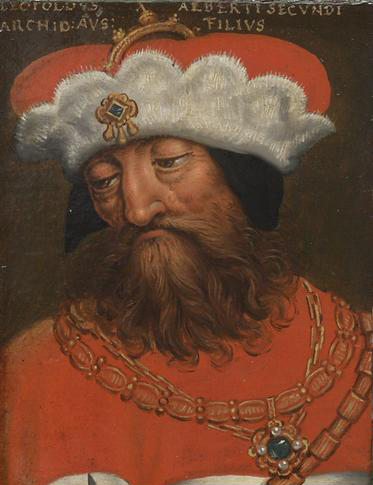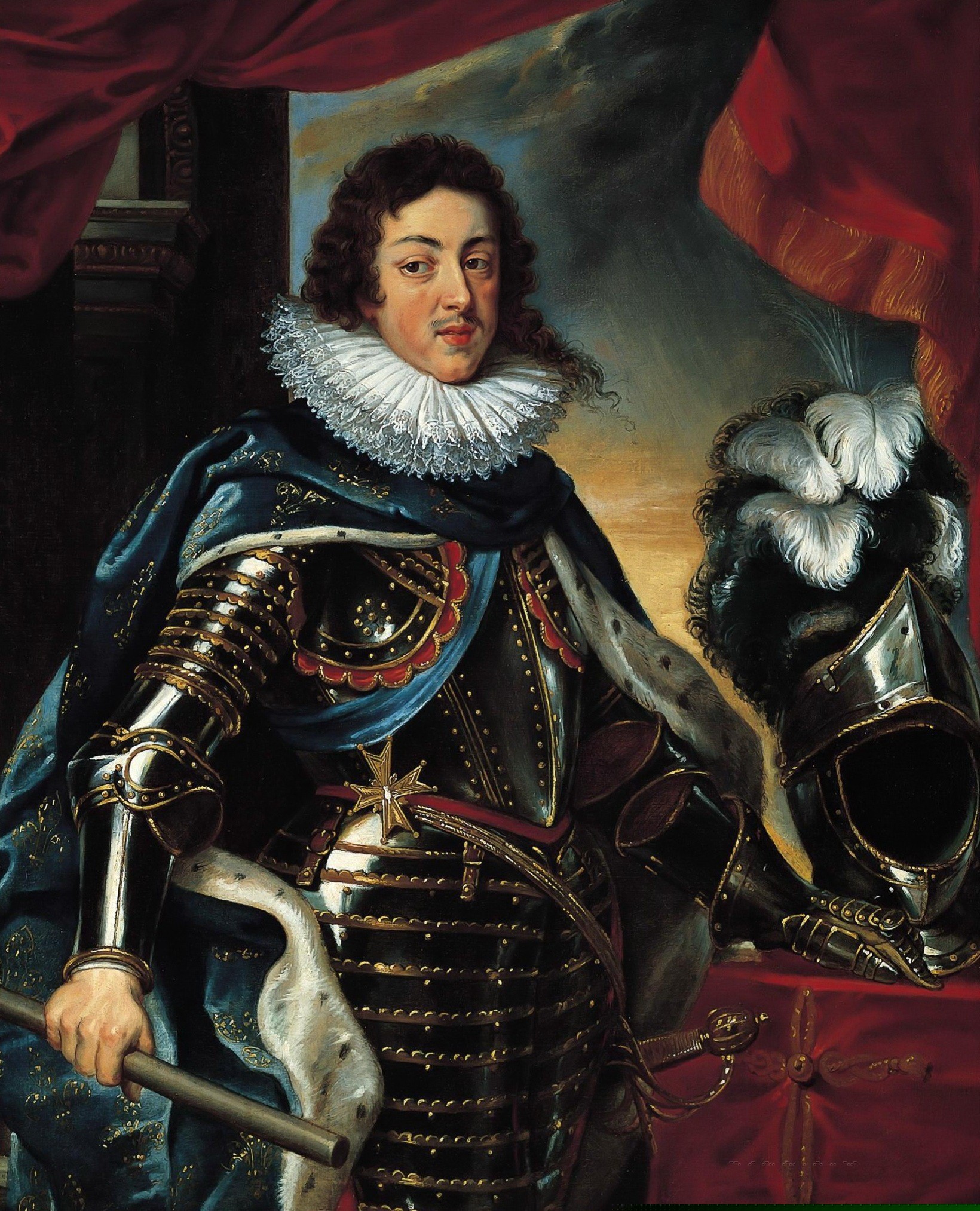|
Wilhelm Lamormaini
Wilhelm Germain Lamormaini (29 December 1570 – 22 February 1648) was a Jesuit theologian, and an influential figure as confessor of the Habsburg emperor Ferdinand II during the Thirty Years' War. Life Lamormaini was born near Dochamps in the Duchy of Luxembourg (nowadays part of Manhay in the Belgian Luxembourg province), since 1482 part of the Habsburg Netherlands. His father, Everard Germain, was a farmer at the hamlet of Lamormenil, hence the name. Lamormaini studied first at the Jesuit gymnasium of Trier, and thence went to Prague, where he received his doctor's degree, and in 1590 entered the Jesuit Order in Brno. Ordained priest at Bratislava in 1596 and afterwards working as a teacher in Žilina and Prague, he was called to the Jesuit University of Graz in Styria as professor of philosophy in 1600, became professor of theology in 1606, and in 1614 was appointed rector of the college. His strong Catholic manners attracted Archduke Ferdinand II of Inner Austria, then ... [...More Info...] [...Related Items...] OR: [Wikipedia] [Google] [Baidu] |
Inner Austria
Inner Austria (; ; ) was a term used from the late 14th to the early 17th century for the Habsburg hereditary lands south of the Semmering Pass, referring to the Imperial duchies of Styria, Carinthia and Carniola and the lands of the Austrian Littoral. The residence of the Inner Austrian archdukes and stadtholders was at the ''Burg'' castle complex in Graz. Geography The Inner Austrian territory stretched from the northern border with the Archduchy of Austria on the Alpine divide over Upper and Lower Styria down to Carniola, where the Lower and White Carniolan lands (the former Windic March) bordered on the Habsburg Kingdom of Croatia. In the west, the Carinthian lands stretched to the Archbishopric of Salzburg and the Habsburg County of Tyrol, while in the east, the Mur River formed the border with the Kingdom of Hungary. In the south, the County of Görz, which had passed to the House of Habsburg in 1500, and Duino (''Tybein'') bordered on the ''Domini di Terraferma'' o ... [...More Info...] [...Related Items...] OR: [Wikipedia] [Google] [Baidu] |
Cardinal Richelieu
Armand Jean du Plessis, 1st Duke of Richelieu (9 September 1585 – 4 December 1642), commonly known as Cardinal Richelieu, was a Catholic Church in France, French Catholic prelate and statesman who had an outsized influence in civil and religious affairs. He became known as the Red Eminence (), a term derived from the style of Eminence (style), Eminence applied to Cardinal (Catholic Church), cardinals and their customary red robes. Consecrated a bishop in 1607, Richelieu was appointed Secretary of State for Foreign Affairs (France), Foreign Secretary in 1616. He continued to rise through the hierarchy of both the Catholic Church and the French government, becoming a Cardinal (Catholic Church), cardinal in 1622 and Chief minister of France, chief minister to King Louis XIII, Louis XIII of France in 1624. He retained that office until his death in 1642, when he was succeeded by Cardinal Cardinal Mazarin, Jules Mazarin, whose career the cardinal had fostered. Richelieu became enga ... [...More Info...] [...Related Items...] OR: [Wikipedia] [Google] [Baidu] |
Habsburg Spain
Habsburg Spain refers to Spain and the Hispanic Monarchy (political entity), Hispanic Monarchy, also known as the Rex Catholicissimus, Catholic Monarchy, in the period from 1516 to 1700 when it was ruled by kings from the House of Habsburg. In this period the Spanish Empire was at the zenith of its influence and power. During this period, Spain held many territories, including American continental holdings and the Spanish West Indies, West Indies; European territories like the Habsburg Netherlands, Low Countries, Council of Italy, Italian territories, Iberian Union, Portugal and parts of County of Burgundy, France; and the Captaincy General of the Philippines, Philippines and other possessions in Southeast Asia. The period of Spanish history has also been referred to as the "Age of Discovery, Age of Expansion". The Habsburg name was not always used by the family members, who often emphasized their more prestigious princely titles. The dynasty was long known as the "House of Austr ... [...More Info...] [...Related Items...] OR: [Wikipedia] [Google] [Baidu] |
War Of The Mantuan Succession
The War of the Mantuan Succession, from 1628 to 1631, was caused by the death in December 1627 of Vincenzo II, last male heir from the House of Gonzaga, long-time rulers of Mantua and Montferrat. Their strategic importance led to a proxy war between the French-backed Duke of Nevers, and the Duke of Guastalla, supported by Spain. It is considered a related conflict of the 1618 to 1648 Thirty Years' War. Fighting centred on the fortress of Casale Monferrato, which the Spanish besieged twice, from March 1628 to April 1629 and from September 1629 to October 1630. French intervention on behalf of Nevers in April 1629 led Emperor Ferdinand II to support Spain by transferring Imperial troops from Northern Germany, who captured Mantua in July 1630. However, French reinforcements enabled Nevers to retain Casale, while Ferdinand withdrew his troops in response to Swedish intervention in the Thirty Years' War, and both sides agreed a truce in October 1630. The June 1631 Treaty of Che ... [...More Info...] [...Related Items...] OR: [Wikipedia] [Google] [Baidu] |
Early Modern France
The Kingdom of France in the early modern period, from the French Renaissance, Renaissance () to the French Revolution, Revolution (1789–1804), was a monarchy ruled by the House of Bourbon (a Capetian dynasty, Capetian cadet branch). This corresponds to the so-called ''Ancien Régime'' ("old rule"). The territory of France during this period territorial evolution of France, increased until it included essentially the extent of the France, modern country, and it also included the territories of the French colonization of the Americas, first French colonial empire overseas. The period is dominated by the figure of the "Sun King", Louis XIV (his reign of 1643–1715 being one of the List of longest-reigning monarchs, longest in history), who managed to eliminate the remnants of medieval France, medieval feudalism and established a centralized government, centralized state under an absolute monarchy, absolute monarch, a system that would endure until the French Revolution and First ... [...More Info...] [...Related Items...] OR: [Wikipedia] [Google] [Baidu] |
Holy Roman Emperor
The Holy Roman Emperor, originally and officially the Emperor of the Romans (other), Emperor of the Romans (; ) during the Middle Ages, and also known as the Roman-German Emperor since the early modern period (; ), was the ruler and head of state of the Holy Roman Empire. The title was held in conjunction with the title of King of Italy#Kingdom of Italy (781–962), King of Italy (''Rex Italiae'') from the 8th to the 16th century, and, almost without interruption, with the title of King of Germany (''Rex Teutonicorum'', ) throughout the 12th to 18th centuries. The Holy Roman Emperor title provided the highest prestige among Christianity in the Middle Ages, medieval Catholic monarchs, because the empire was considered by the Catholic Church to be Translatio imperii, the only successor of the Roman Empire during the Middle Ages and the early modern period. Thus, in theory and diplomacy, the emperors were considered first among equalsamong other Catholic monarchs across E ... [...More Info...] [...Related Items...] OR: [Wikipedia] [Google] [Baidu] |
Edict Of Restitution
The Edict of Restitution was proclaimed by Ferdinand II, Holy Roman Emperor in Vienna, on 6 March 1629, eleven years into the Thirty Years' War. Following Catholic League (German), Catholic military successes, Ferdinand hoped to restore control of land to that specified in the Peace of Augsburg (1555). That treaty's "Reservatum ecclesiasticum, Ecclesiastical Reservation" had prohibited further secularization of lands held by the Catholic church after 1555, disallowing any transfer of such lands to Protestant control. However, as the Holy Roman Empire descended into the Thirty Years' War, weak emperors had been unable to enforce this provision against Protestant encroachments. Background The Diet of Speyer (1529) introduced the principle of ''cuius regio, eius religio'': in essence, agreeing to disagree within the Holy Roman Empire. With that principle confirmed by the Peace of Augsburg, large-scale violence between Lutherans and Catholics in Germany was temporarily avoided. S ... [...More Info...] [...Related Items...] OR: [Wikipedia] [Google] [Baidu] |
Protestant Reformation
The Reformation, also known as the Protestant Reformation or the European Reformation, was a time of major theological movement in Western Christianity in 16th-century Europe that posed a religious and political challenge to the papacy and the authority of the Catholic Church. Towards the end of the Renaissance, the Reformation marked the beginning of Protestantism. It is considered one of the events that signified the end of the Middle Ages and the beginning of the early modern period in Europe. The Reformation is usually dated from Martin Luther's publication of the '' Ninety-five Theses'' in 1517, which gave birth to Lutheranism. Prior to Martin Luther and other Protestant Reformers, there were earlier reform movements within Western Christianity. The end of the Reformation era is disputed among modern scholars. In general, the Reformers argued that justification was based on faith in Jesus alone and not both faith and good works, as in the Catholic view. In the ... [...More Info...] [...Related Items...] OR: [Wikipedia] [Google] [Baidu] |
Counter-Reformation
The Counter-Reformation (), also sometimes called the Catholic Revival, was the period of Catholic resurgence that was initiated in response to, and as an alternative to or from similar insights as, the Protestant Reformations at the time. It was a comprehensive effort arising from the decrees of the Council of Trent. As a political-historical period, it is frequently dated to have begun with the Council of Trent (1545–1563) and to have ended with the political conclusion of the European wars of religion in 1648, though this is controversial. However, as a theological-historical description, the term may be obsolescent or over-specific: the broader term Catholic Reformation () also encompasses the reforms and movements within the Church in the periods immediately before Protestantism or Trent, and lasting later. The effort produced Apologetics, apologetic and polemical documents, anti-corruption efforts, spiritual movements, the promotion of new religious orders, and the flo ... [...More Info...] [...Related Items...] OR: [Wikipedia] [Google] [Baidu] |
Martin Becan
Martinus Becanus (6 January 1563 – 24 January 1624) was a Dutch-born Jesuit priest, known as a theologian and controversialist. Life He was born ''Maarten Schellekens'' in Hilvarenbeek in North Brabant; Schellekens is a patronymic and he adopted a Latinized form of the surname Van (Hilvaren)Beek. He entered the Society of Jesus on 22 March 1583, and taught Theology for twenty-two years at Würzburg, Mainz, and Vienna. He died in Vienna, where he was the confessor to the Emperor Ferdinand II. Works Becanus is the author of some 37 books, most of them works of polemics. *He developed the art of controversy and taught it in his book: ''Manuale controversiarum huius temporis'' published in Wurzburg (1623), that went into more than 50 editions (in the shortened version until the late 18th century). *In ''De fide haereticis servanda (1607)'' he defended against the opinion of Panormitanus the view that Protestants and Catholics should observe contracts concluded between one anot ... [...More Info...] [...Related Items...] OR: [Wikipedia] [Google] [Baidu] |
Gout
Gout ( ) is a form of inflammatory arthritis characterized by recurrent attacks of pain in a red, tender, hot, and Joint effusion, swollen joint, caused by the deposition of needle-like crystals of uric acid known as monosodium urate crystals. Pain typically comes on rapidly, reaching maximal intensity in less than 12 hours. The Metatarsophalangeal joint, joint at the base of the Hallux, big toe is affected (''Podagra'') in about half of cases. It may also result in Tophus, tophi, kidney stones, or Urate nephropathy, kidney damage. Gout is due to persistently elevated levels of uric acid (urate) in the blood (hyperuricemia). This occurs from a combination of diet, other health problems, and genetic factors. At high levels, uric acid crystallizes and the crystals deposit in joints, tendons, and surrounding tissues, resulting in an attack of gout. Gout occurs more commonly in those who regularly drink beer or sugar-sweetened beverages; eat foods that are high in purines such ... [...More Info...] [...Related Items...] OR: [Wikipedia] [Google] [Baidu] |









